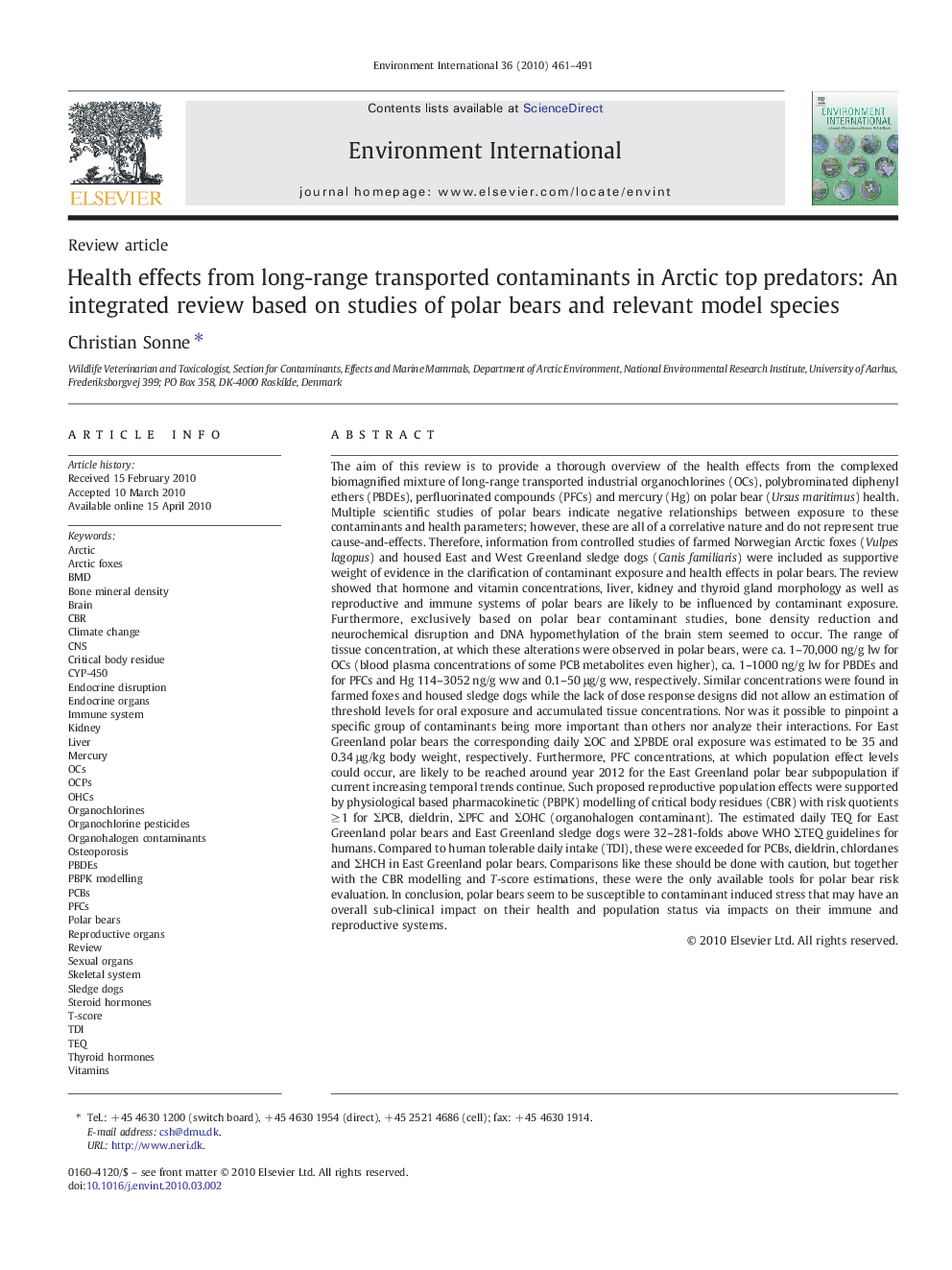| کد مقاله | کد نشریه | سال انتشار | مقاله انگلیسی | نسخه تمام متن |
|---|---|---|---|---|
| 4423271 | 1308818 | 2010 | 31 صفحه PDF | دانلود رایگان |

The aim of this review is to provide a thorough overview of the health effects from the complexed biomagnified mixture of long-range transported industrial organochlorines (OCs), polybrominated diphenyl ethers (PBDEs), perfluorinated compounds (PFCs) and mercury (Hg) on polar bear (Ursus maritimus) health. Multiple scientific studies of polar bears indicate negative relationships between exposure to these contaminants and health parameters; however, these are all of a correlative nature and do not represent true cause-and-effects. Therefore, information from controlled studies of farmed Norwegian Arctic foxes (Vulpes lagopus) and housed East and West Greenland sledge dogs (Canis familiaris) were included as supportive weight of evidence in the clarification of contaminant exposure and health effects in polar bears. The review showed that hormone and vitamin concentrations, liver, kidney and thyroid gland morphology as well as reproductive and immune systems of polar bears are likely to be influenced by contaminant exposure. Furthermore, exclusively based on polar bear contaminant studies, bone density reduction and neurochemical disruption and DNA hypomethylation of the brain stem seemed to occur. The range of tissue concentration, at which these alterations were observed in polar bears, were ca. 1–70,000 ng/g lw for OCs (blood plasma concentrations of some PCB metabolites even higher), ca. 1–1000 ng/g lw for PBDEs and for PFCs and Hg 114–3052 ng/g ww and 0.1–50 μg/g ww, respectively. Similar concentrations were found in farmed foxes and housed sledge dogs while the lack of dose response designs did not allow an estimation of threshold levels for oral exposure and accumulated tissue concentrations. Nor was it possible to pinpoint a specific group of contaminants being more important than others nor analyze their interactions. For East Greenland polar bears the corresponding daily ΣOC and ΣPBDE oral exposure was estimated to be 35 and 0.34 μg/kg body weight, respectively. Furthermore, PFC concentrations, at which population effect levels could occur, are likely to be reached around year 2012 for the East Greenland polar bear subpopulation if current increasing temporal trends continue. Such proposed reproductive population effects were supported by physiological based pharmacokinetic (PBPK) modelling of critical body residues (CBR) with risk quotients ≥ 1 for ΣPCB, dieldrin, ΣPFC and ΣOHC (organohalogen contaminant). The estimated daily TEQ for East Greenland polar bears and East Greenland sledge dogs were 32–281-folds above WHO ΣTEQ guidelines for humans. Compared to human tolerable daily intake (TDI), these were exceeded for PCBs, dieldrin, chlordanes and ΣHCH in East Greenland polar bears. Comparisons like these should be done with caution, but together with the CBR modelling and T-score estimations, these were the only available tools for polar bear risk evaluation. In conclusion, polar bears seem to be susceptible to contaminant induced stress that may have an overall sub-clinical impact on their health and population status via impacts on their immune and reproductive systems.
Journal: Environment International - Volume 36, Issue 5, July 2010, Pages 461–491